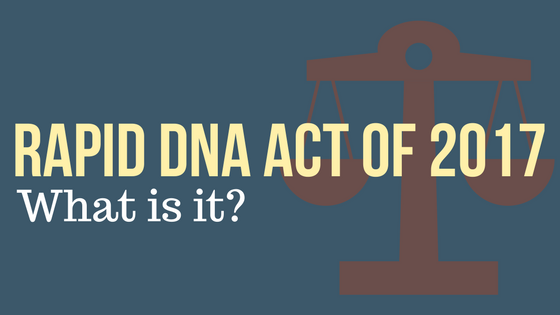On May 16, 2017, the U.S House of Representatives and the U.S. Senate passed the Rapid DNA Act of 2017 (H.R.510 and S.139, respectively). The bill was sponsored by Senator Orrin Hatch (R-UT) and Representative James Sensenbrenner (R-Wis) and enjoyed bipartisan support, ending up with seven Republican and five Democratic cosponsors in the Senate, and seventeen Republican and seven Democratic cosponsors in the House. The bill was passed by unanimous consent voice votes in both chambers.
Written by: Kelly Grooms, Promega
So what is the Rapid DNA Act of 2017 all about?
Simply put, the act will expand the use of rapid DNA technology in law enforcement departments by creating a way for them to use the results they get by connecting them to the FBIs Combined DNA Index System (CODIS). Still curious? Read on and you will learn much more about what the Rapid DNA Act of 2017 does and doesn’t do.
What is Rapid DNA?
Rapid DNA (or Rapid DNA Analysis) is a fully automated technique that can develop a CODIS Core Loci STR profile from a reference sample buccal swab in approximately 90 minutes. It consists of automated DNA extraction, amplification, separation, detection and analysis (allele calling), and requires no human intervention after the sample is collected and placed in the instrument.
What Can Rapid DNA Be Used For? 
Rapid DNA can be used to develop a profile much more quickly than traditional methods using a buccal swab reference sample. This means that trained law enforcement officers could obtain the DNA profile of a suspect and compare it to those in the National DNA Index System (NDIS) in a timeframe (under two hours), allowing them to hold suspects whose profile matched one in the system.
What Can’t Rapid DNA Be Used For?
Rapid DNA technology cannot be used to generate profiles using forensic (crime scene) samples. This is because forensic samples are often limited in quantity, of variable quality, and could contain material from more than one individual.
Has Rapid DNA Ever Been Used in a Criminal Case?
Yes. Rapid DNA was used for the first time in a criminal investigation in 2013. The case involved the theft of over $30,000 of items from a residence in Florida. The burglary occurred while the home owner was serving overseas with the Air Force. In another example, Tullytown, PA police used a Rapid DNA system to catch a car thief.
Will the Rapid DNA Legislation Help Alleviate the Sample Backlog in Crime Labs?
Rapid DNA technologies will help address one type of sample that crime labs test. Once implemented, trained officers will be able to process reference samples buccal swabs collected from people of interest and generate the CODIS profile without sending the sample to the lab. This will decrease the number of overall samples a crime lab would need to process. Rapid DNA technology will not help in the backlog of forensic samples (crime scene samples, rape kit samples, etc.).
When Will Rapid DNA Begin to Be Used by Law Enforcement?
Clearly, it will take time for law enforcement agencies to be trained, acquire the necessary equipment and for all of the related systems to be connected. According to information found on the FBI website, the FBI intends to develop and implement the interfaces needed for booking stations to access CODIS within one to two years.
Final Thoughts
The Rapid DNA Act of 2017 has its share of supporters and detractors. Supporters say it will speed the DNA analysis process, save valuable time and reduce the backlog of samples in crime labs. Detractors argue that much of the backlog is comprised of samples that aren’t compatible with rapid DNA technologies (see above) and raise concerns about privacy violations and misuse by immigration authorities.
The truth is probably somewhere in the middle. Taking the burden of processing reference samples off of crime labs will free their some of their time, allowing them to process more of the back logged samples. At the same time collecting biological information from individuals requires sensitivity and careful regulation and oversight.
WOULD YOU LIKE TO SEE MORE ARTICLES LIKE THIS? SUBSCRIBE TO THE ISHI BLOG BELOW!
SUBSCRIBE NOW!


